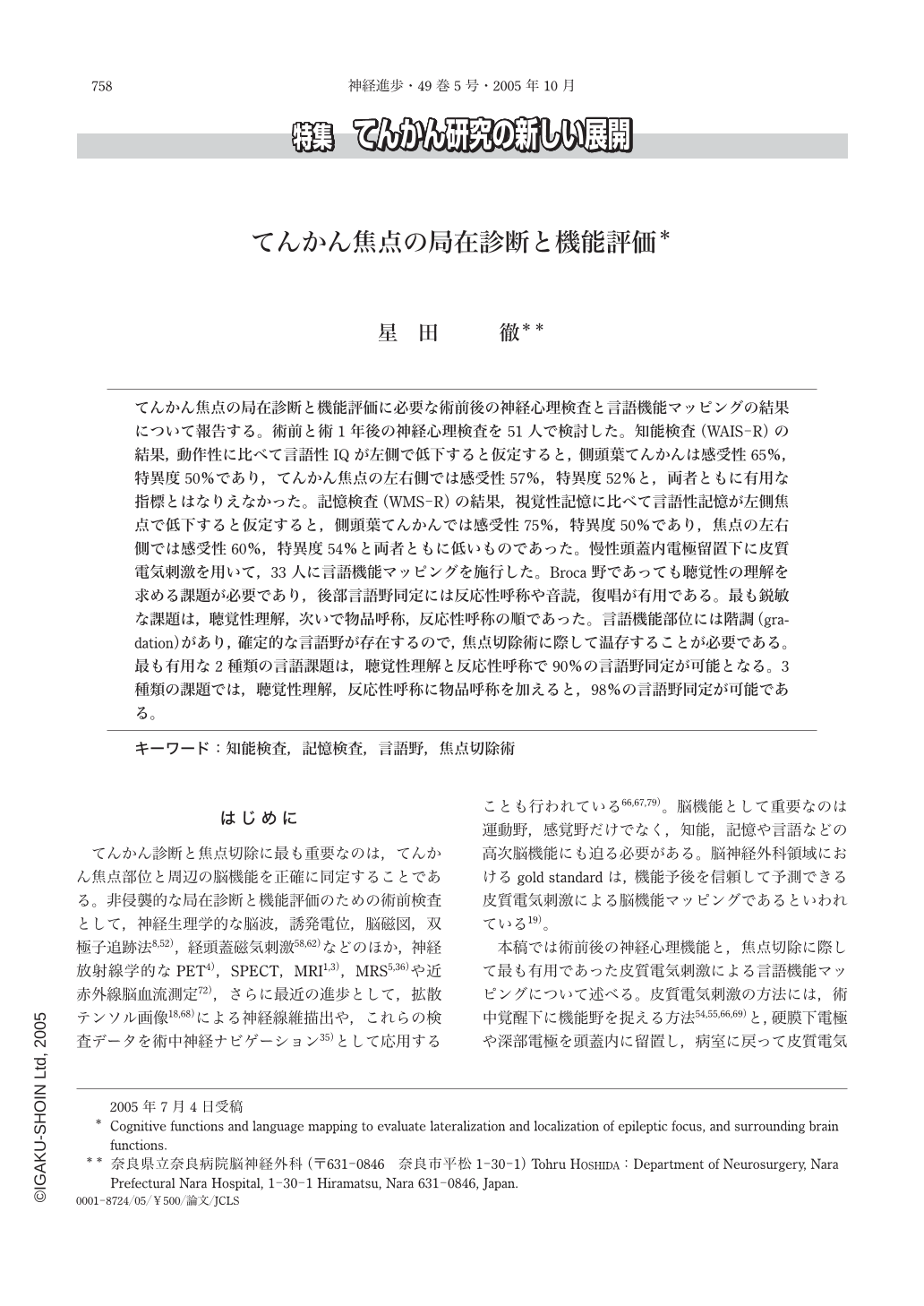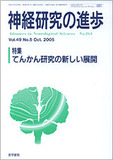Japanese
English
- 有料閲覧
- Abstract 文献概要
- 1ページ目 Look Inside
てんかん焦点の局在診断と機能評価に必要な術前後の神経心理検査と言語機能マッピングの結果について報告する。術前と術1年後の神経心理検査を51人で検討した。知能検査(WAIS-R)の結果,動作性に比べて言語性IQが左側で低下すると仮定すると,側頭葉てんかんは感受性65%,特異度50%であり,てんかん焦点の左右側では感受性57%,特異度52%と,両者ともに有用な指標とはなりえなかった。記憶検査(WMS-R)の結果,視覚性記憶に比べて言語性記憶が左側焦点で低下すると仮定すると,側頭葉てんかんでは感受性75%,特異度50%であり,焦点の左右側では感受性60%,特異度54%と両者ともに低いものであった。慢性頭蓋内電極留置下に皮質電気刺激を用いて,33人に言語機能マッピングを施行した。Broca野であっても聴覚性の理解を求める課題が必要であり,後部言語野同定には反応性呼称や音読,復唱が有用である。最も鋭敏な課題は,聴覚性理解,次いで物品呼称,反応性呼称の順であった。言語機能部位には階調(gradation)があり,確定的な言語野が存在するので,焦点切除術に際して温存することが必要である。最も有用な2種類の言語課題は,聴覚性理解と反応性呼称で90%の言語野同定が可能となる。3種類の課題では,聴覚性理解,反応性呼称に物品呼称を加えると,98%の言語野同定が可能である。
The significance of pre- and post-operative cognitive functions and perioperative language mapping using chronically implanted subdural grids to evaluate epileptic focus and surrounding brain functions was examined. Neuropsychological functions were evaluated using WAIS-R, WMS, and WMS-R before and one year after resective surgery in 51 epilepsy patients. Presurgical verbal IQ was not always lower than performance IQ even if the epilepsy focus was localized in the left temporal lobe or left hemisphere. Postsurgical verbal IQ, performance IQ, and full scale IQ were significantly higher than the corresponding presurgical IQs in 51 patients. Verbal IQ was of ten improved postsurgically even if the focus was in the left temporal lobe or left hemisphere. Lower verbal IQ than performance IQ predicts the localization of epilepsy focus in the left temporal lobe with 65% sensitivity and 50% specificity, and predicts lateralization in the left hemisphere with 57% sensitivity and 52% specificity. The results suggest that WAIS-R is not a reliable test to evaluate temporal lobe function or to detect functional lateralization in the hemispheres, but is a valid test to evaluate global brain functions.
According to the WMS and WMS-R results, presurgical verbal memory was not always significantly worse than visual memory even if the epilepsy focus was located in the left temporal lobe or left hemisphere. Verbal memory and visual memory were improved after surgery in 49 patients and a significant improvement was observed only with verbal memory comparing right versus left temporal lobe epilepsy and extratemporal versus temporal lobe epilepsy. Visual memory was not significantly different comparing right versus left, or temporal versus extratemporal lobe epilepsy. Lower verbal memory than visual memory predicts localization of the epilepsy focus in the left temporal lobe with 75% sensitivity and 50% specificity, and predicts lateralization in the left hemisphere with 60% sensitivity and 54% specificity. These results indicate that WMS and WMS-R are not useful cognitive test to evaluate lateralization of the epileptic focus.
Language mapping was studied in 33 patients using chronic subdural grid recording and electrical cortical stimulation. Areas showing speech arrest after cortical stimulation were not limited to the language areas, while there were also some language areas that demonstrated no speech arrest. Auditory comprehension task was most sensitive to detect anterior language(Broca's)area, while responsive naming, reading, and repetition tasks were more sensitive to detect posterior language(Wernicke's)area. The most useful and sensitive language task was auditory comprehension(79%), followed by picture naming(77%), responsive naming(70%)and reading(37%).
The concept of functional gradation in language is very interesting and important. One gradation concept is that there are core or central portions(with reliable and positive language function), and peripheral portions(with unreliable and provably positive function)within each language area detected by one of six language tasks. Another gradation concept is that there are core or central portions(areas in which many language tasks are positive, indicating more definite language areas)and peripheral portions(areas in which only one or two language tasks are positive, indicating less definite language areas)among the language areas detected by performing all six language tasks. It is mandatory to detect and preserve definite language areas to avoid neurological function deterioration after resective surgery. The most reliable pair of two-language-tasks was auditory comprehension and responsive naming, which was able to identify 90% of language areas. The most useful combination of three-language-tasks was picture naming, auditory comprehension and responsive naming, which was able to identify 98% of language areas.

Copyright © 2005, Igaku-Shoin Ltd. All rights reserved.


